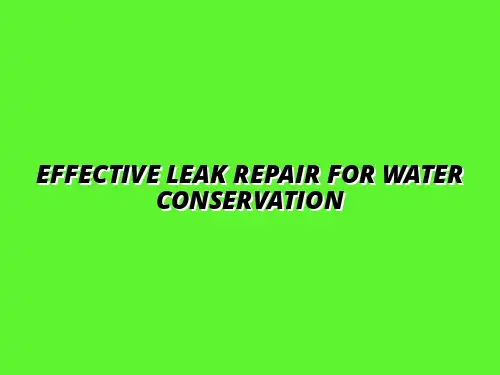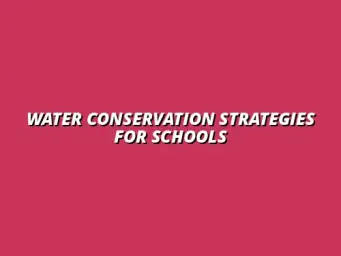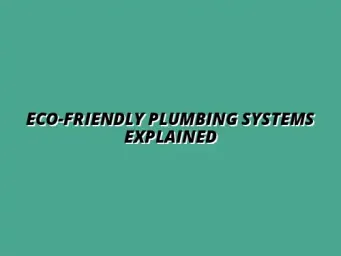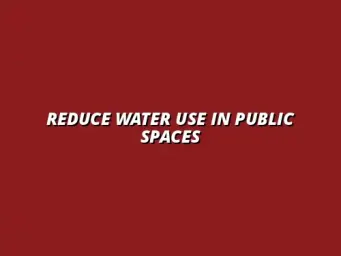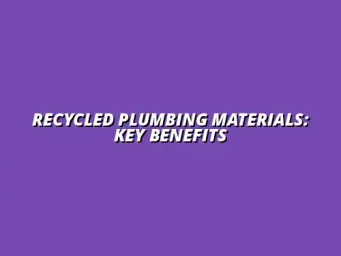Understanding Water Conservation and Its Importance
Water conservation is a practice that focuses on using water efficiently to reduce unnecessary water usage. It’s essential because fresh water is a limited resource, and conserving it can help preserve our environment and sustain future generations. By understanding the importance of saving water, we can make informed choices that positively impact our households and communities. For practical tips on reducing daily water waste, check out these water-saving tips for homeowners.
The benefits of water conservation extend beyond just the environment. It helps in reducing utility bills and allows more families to access clean water. Developing habits to conserve water can be as simple as fixing leaks, using less water in daily activities, and being mindful of usage.
Impact of Water Wastage on the Environment
When we waste water, it has a significant impact on our ecosystems. Water wastage can lead to the depletion of local water resources, harm aquatic habitats, and contribute to drought conditions. In many regions, this can disrupt the balance in nature, affecting both wildlife and plant life.
Moreover, the energy used to pump, heat, and treat water adds to our carbon footprint. By understanding how water wastage affects the environment, we can make better decisions to help protect our planet. Here are some key impacts:
- Decreased water levels in rivers and lakes
- Loss of biodiversity due to habitat destruction
- Increased energy consumption leading to higher greenhouse gas emissions
Benefits of Conserving Water for Households and Communities
Conserving water brings a wealth of benefits to both households and communities. First and foremost, it helps reduce utility bills, allowing families to save money each month. Additionally, when we conserve water, we contribute to maintaining a sustainable water supply for future generations. Learn more about saving water in your bathroom with these helpful tips from PlumbProCare.
Furthermore, communities that prioritize water conservation often experience improved water quality and availability. This can foster a sense of community pride and awareness. Here’s a list of benefits that come with conserving water:
- Lower monthly water bills
- Reduced demand on local water supply
- Enhanced ecosystem health
- Improved community resilience against drought
Recognizing Common Leak Sources in Homes
Leaks in our homes can lead to significant water wastage. Identifying these leaks promptly is essential to conserving water and reducing costs. In this section, we will explore common sources of leaks and what to do about them. For example, a leaky kitchen faucet can waste a surprising amount of water, so knowing how to fix a leaky kitchen faucet is crucial.
It’s important to check areas of your home regularly for leaks, as these can often go unnoticed. Taking the time to inspect plumbing fixtures and common leak-prone areas can save you water and money over time.
Identifying Plumbing Fixtures That Often Leak
Several plumbing fixtures are notorious for leaking. Understanding where to look can help you catch leaks early. Common fixtures that often develop leaks include:
- Toilets: Flapper valve failures are a common issue.
- Faucets: Worn washers or O-rings can lead to drips.
- Showerheads: Mineral build-up and faulty seals can cause leaks.
Regular checks and maintenance of these fixtures can prevent minor leaks from turning into major problems. It's a small effort that can yield significant savings!
Common Areas in the Home Prone to Leaks
Beyond individual fixtures, certain areas in the home are more likely to experience leaks. Identifying these high-risk areas can help you stay ahead of potential issues. Here are some common leak-prone areas:
- Bathrooms: Toilets, showers, and sinks are frequent culprits.
- Kitchen: Dishwashers, sinks, and refrigerator water lines.
- Basements: Water heaters and plumbing connections can leak.
By keeping an eye on these areas, you can catch leaks early and avoid costly water damage. Preventative maintenance, such as regularly checking your water heater, is key to avoiding leaks. Learn more about preventing water heater leaks.
Bathroom Leaks: Toilets, Showers, and Faucets
The bathroom is one of the most common places for leaks. Toilets are known for running continuously, which wastes a lot of water. Showerheads and faucets can also develop leaks due to wear and tear over time.
Here are some tips to manage bathroom leaks:
- Check toilets for running water and replace flapper valves if needed.
- Inspect showerheads for mineral deposits and replace washers as necessary.
- Test faucets for drips and replace worn parts to fix leaks.
Kitchen and Laundry Room Leak Potential
In the kitchen and laundry room, leaks can happen in several places. Dishwashers and washing machines are often the main sources. Leaks can occur due to worn hoses or loose connections, leading to water loss. Saving water while washing dishes is easier than you think – check out these tips on saving water while washing dishes.
To minimize leaks in these areas, consider the following:
- Regularly inspect hoses for brittle or cracked surfaces.
- Tighten any loose connections to prevent leaks.
- Install drip trays under appliances to catch small leaks early.
Taking these proactive steps can help keep your home dry and your water bills low!
Long-Term Maintenance to Prevent Future Leaks
Taking care of your plumbing is essential for avoiding leaks down the line. Regular maintenance can help spot issues before they turn into costly repairs. By committing to a few simple checks, you not only save water but also extend the life of your plumbing system! For comprehensive water saving advice, consider reading water-saving tips for homeowners.
One key aspect is scheduling regular inspections of your plumbing. This proactive approach can prevent minor problems from escalating. Plus, being aware of the condition of your plumbing helps you make informed decisions about repairs and replacements.
Regular Inspections: Keeping Your Plumbing in Check
Regular inspections are a great way to keep an eye on your plumbing health. It’s important to check for signs of wear and tear, especially in older systems. Here are some things you should look for during inspections:
- Signs of mold or mildew around fixtures
- Corrosion or rust on pipes
- Unusual water stains on ceilings and walls
- Changes in water pressure or flow
These checks can save you a lot of headaches later! If you find any concerning signs, addressing them quickly can make a significant difference.
Seasonal Maintenance Tips for Plumbing Systems
Seasonal maintenance is crucial to prevent leaks, especially as the weather changes. Here are some tips to keep your plumbing systems in top shape:
- Inspect outdoor faucets and hoses before winter.
- Flush your water heater at least once a year.
- Check for leaks in areas prone to temperature changes.
- Seal any gaps or cracks around pipes to prevent freezing.
Following these tips can help ensure that your plumbing remains leak-free throughout the seasons!
Importance of Water Softening Systems
Water softening systems can play a vital role in maintaining your plumbing. Hard water can lead to buildup that may cause leaks over time. A water softener reduces mineral deposits, which can protect your pipes and fixtures.
By investing in a water softening system, you can enjoy several benefits:
- Reduced buildup in pipes
- Longer lifespan for appliances
- Less soap needed for cleaning
- Improved skin and hair health
With a water softener, you can not only improve water quality but also help prevent future plumbing issues!
Frequently Asked Questions on Leak Repair and Water Conservation
When it comes to leak repair and water conservation, I often receive many questions. Understanding these common queries can help you make informed decisions. Here are some frequently asked questions that might clear up your doubts!
How Much Water Can Be Saved by Fixing Leaks?
Fixing leaks can save a significant amount of water! On average, a leaky faucet can waste more than 3,000 gallons of water a year. By taking action, you’ll not only conserve water but also lower your water bill. For assistance with plumbing issues in Bordesley Green, Birmingham, consider contacting a local plumber.
Here’s a quick look at potential savings:
- A dripping faucet: Up to 3,000 gallons/year
- A leaky toilet: Up to 26,000 gallons/year
- Pinhole leak in pipes: Up to 1,000 gallons/month
These numbers show how much an impact fixing leaks can have on both your wallet and the environment!
What Are the Signs of a Major Leak?
Being aware of the signs of major leaks can save you from severe water damage. Common indicators include:
- Sudden increase in water bills
- Puddles or damp spots in your yard
- Water stains on walls or ceilings
- Unusual sounds of running water
If you notice any of these signs, it’s crucial to investigate immediately. Early detection can prevent costly repairs and extensive water damage!
How to Handle Major Water Damage from Leaks?
In case water damage occurs due to a leak, knowing how to respond is vital. First, you should turn off the water supply to prevent further damage. Then, you’ll want to take these steps:
- Remove any valuables or furniture from the affected area.
- Dry the area thoroughly to prevent mold growth.
- Document the damage for insurance purposes.
- Contact a professional for repairs if necessary.
By acting quickly, you can minimize damage and recover faster!
Incorporating Sustainable Practices for Water Conservation
In today's world, incorporating sustainable practices into our daily lives is essential. This includes taking steps for water conservation, especially when repairing leaks. Every action counts, and making eco-friendly choices can lead to significant improvements.
Using Eco-Friendly Materials in Leak Repairs
When fixing leaks, consider using eco-friendly materials. This not only helps the environment but also ensures that your repairs are sustainable. Here are some materials you might want to use:
- Biodegradable sealants
- Recycled pipes and fixtures
- Low-flow faucets and fixtures
Choosing these materials can make your repairs greener and help in reducing your environmental footprint.
Integrating Water-Saving Fixtures for Long-Term Savings
Installing water-saving fixtures is a smart move for long-term water conservation. These fixtures help reduce water usage without sacrificing performance. Below are some popular options:
- Low-flow showerheads
- Dual-flush toilets
- Water-efficient washing machines
By making these upgrades, you can save water and also see a reduction in your utility bills!
Summarizing Key Practices for Effective Leak Repair
In conclusion, addressing leaks and conserving water is an ongoing effort that benefits everyone. By taking prompt action and following best practices, you can keep your plumbing in good shape. Remember, small changes can lead to big results!
The Importance of Prompt Action on Leak Repairs
Timing is everything when it comes to leak repairs. The sooner you address a leak, the less damage it can cause. Prompt action not only saves water but also helps prevent costly repairs in the future.
Here are some reasons why timely repairs matter:
- Minimizes water waste
- Prevents mold and mildew growth
- Reduces damage to your property
Taking quick action ensures that your home remains safe and efficient!
Encouraging Community Awareness on Water Conservation Efforts
Lastly, raising awareness in your community about water conservation is essential for long-term change. The more people understand the importance of saving water, the greater the impact. You can help by sharing information and resources with others.
Consider these ideas for spreading awareness:
- Organize community workshops on leak detection and repair
- Share tips on social media
- Partner with local organizations for conservation campaigns
By working together, we can make a difference and promote a culture of conservation!

